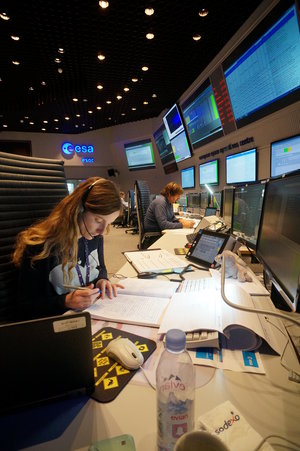Accept all cookies Accept only essential cookies See our Cookie Notice

About ESA
The European Space Agency (ESA) is Europe’s gateway to space. Its mission is to shape the development of Europe’s space capability and ensure that investment in space continues to deliver benefits to the citizens of Europe and the world.
Highlights
ESA - United space in Europe
This is ESA ESA facts Member States & Cooperating States Funding Director General Top management For Member State Delegations European vision European Space Policy ESA & EU Space Councils Responsibility & Sustainability Annual Report Calendar of meetings Corporate newsEstablishments & sites
ESA Headquarters ESA ESTEC ESA ESOC ESA ESRIN ESA EAC ESA ESAC Europe's Spaceport ESA ESEC ESA ECSAT Brussels Office Washington OfficeWorking with ESA
Business with ESA ESA Commercialisation Gateway Law at ESA Careers Cyber resilience at ESA IT at ESA Newsroom Partnerships Merchandising Licence Education Open Space Innovation Platform Integrity and Reporting Administrative Tribunal Health and SafetyMore about ESA
History ESA Historical Archives Exhibitions Publications Art & Culture ESA Merchandise Kids Diversity ESA Brand Centre ESA ChampionsLatest
Space in Member States
Find out more about space activities in our 23 Member States, and understand how ESA works together with their national agencies, institutions and organisations.
Science & Exploration
Exploring our Solar System and unlocking the secrets of the Universe
Go to topicAstronauts
Missions
Juice Euclid Webb Solar Orbiter BepiColombo Gaia ExoMars Cheops Exoplanet missions More missionsActivities
International Space Station Orion service module Gateway Concordia Caves & Pangaea BenefitsLatest
Space Safety
Protecting life and infrastructure on Earth and in orbit
Go to topicAsteroids
Asteroids and Planetary Defence Asteroid danger explained Flyeye telescope: asteroid detection Hera mission: asteroid deflection Near-Earth Object Coordination CentreSpace junk
About space debris Space debris by the numbers Space Environment Report In space refuelling, refurbishing and removingSafety from space
Clean Space ecodesign Zero Debris Technologies Space for Earth Supporting Sustainable DevelopmentLatest
Applications
Using space to benefit citizens and meet future challenges on Earth
Go to topicObserving the Earth
Observing the Earth Future EO Copernicus Meteorology Space for our climate Satellite missionsCommercialisation
ESA Commercialisation Gateway Open Space Innovation Platform Business Incubation ESA Space SolutionsLatest
Enabling & Support
Making space accessible and developing the technologies for the future
Go to topicBuilding missions
Space Engineering and Technology Test centre Laboratories Concurrent Design Facility Preparing for the future Shaping the Future Discovery and Preparation Advanced Concepts TeamSpace transportation
Space Transportation Ariane Vega Space Rider Future space transportation Boost! Europe's Spaceport Launches from Europe's Spaceport from 2012Latest

Training to succeed
Thank you for liking
You have already liked this page, you can only like it once!
It's thirty-seven days to launch of the Copernicus Sentinel-5P satellite, and the mission control team at the European Space Operations Centre (ESOC), Darmstadt, Germany, are getting ready to handle any eventuality. Pressure is high, and even though ESOC is celebrating 50 years as Europe’s ‘Gateway to Space’ tomorrow, the launch team are keeping all eyes on Sentinel-5P.
Today's simulation, held in the Main Control Room, covers the engineers' worst nightmare: failure to acquire first signals from the spacecraft in space just after it separates from the rocket. This is vital, as the ground teams must immediately establish contact in order to initiate the procedures that will bring the satellite into its correct position.
To react to the failed contact, the Ground Operations team on console in the control room will conduct a sky search, pointing the ground station antenna, via remote control, at the points in the sky where the satellite could be. This is called ‘targeting in the blind’, transmitting commands to a position in space where the spacecraft is expected to pass.
This is not easy, since the satellite might pass too early or too late over the ground station if it is not on its planned trajectory (due to over- or under-performance of the launching rocket). This delicate phase is conducted with little information, relying on skill, experience and teamwork.
For the team at ESOC on this occasion, the simulation was successful. The ground station antenna 'saw' the satellite (but at a different location than expected) and contact was established.
The whole process will be repeated many times until the Flight Director is satisfied that any eventuality can be met.
Sentinel-5P is set for launch on 13 October from the Plesetsk cosmodrome in Russia.
-
CREDIT
ESA -
LICENCE
ESA Standard Licence

Going to space

Team training

Team training

Sentinel-1 team training















 Germany
Germany
 Austria
Austria
 Belgium
Belgium
 Denmark
Denmark
 Spain
Spain
 Estonia
Estonia
 Finland
Finland
 France
France
 Greece
Greece
 Hungary
Hungary
 Ireland
Ireland
 Italy
Italy
 Luxembourg
Luxembourg
 Norway
Norway
 The Netherlands
The Netherlands
 Poland
Poland
 Portugal
Portugal
 Czechia
Czechia
 Romania
Romania
 United Kingdom
United Kingdom
 Slovenia
Slovenia
 Sweden
Sweden
 Switzerland
Switzerland

























